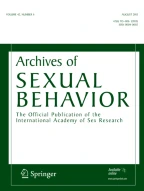References
Blanchard, R. (2009a). The DSM diagnostic criteria for pedophilia. Archives of Sexual Behavior. doi:10.1007/s10508-009-9536-0.
Blanchard, R. (2009b). Reply to letters regarding Pedophilia, Hebephilia, and the DSM-V [Letter to the Editor]. Archives of Sexual Behavior, 38, 331–334. doi:10.1007/s10508-008-9427-9.
Blanchard, R., Kolla, N. J., Cantor, J. M., Klassen, P. E., Dickey, R., Kuban, M. E., & Blak, T. (2007). IQ, handedness, and pedophilia in adult male patients stratified by referral source. Sexual Abuse: A Journal of Research and Treatment, 19, 285–309. doi:10.1177/107906320701900307.
Blanchard, R., Lykins, A. D., Wherrett, D., Kuban, M. E., Cantor, J. M., Blak, T., … Klassen, P. E. (2009). Pedophilia, hebephilia, and the DSM-V. Archives of Sexual Behavior, 38, 335–350. doi:10.1007/s10508-008-9399-9.
Harris, A., Phenix, A., Hanson, R. K., & Thornton, D. (2003). Static-99 coding rules revised—2003. Retrieved on September 12, 2005, from http://www.psepc-sppcc.gc.ca/publications/corrections/pdf/Static-99-coding-Rules_e.pdf.
Neutze, J., Seto, M. C., Schaefer, G. A., Mundt, I. A., & Beier, K. M. (2009). Predictors of child pornography offenses and child sexual abuse in a community sample of pedophiles and hebephiles. Manuscript submitted for publication.
O’Donohue, W., Regev, L. G., & Hagstrom, A. (2000). Problems with the DSM-IV diagnosis of pedophilia. Sexual Abuse: A Journal of Research and Treatment, 12, 95–105. doi:10.1177/107906320001200202.
Quayle, E., & Taylor, M. (2002). Child pornography and the internet: Perpetuating a cycle of abuse. Deviant Behavior, 23, 331–361. doi:10.1080/01639620290086413.
Riegel, D. L. (2004). Effects on boy-attracted pedosexual males of viewing boy erotica [Letter to the Editor]. Archives of Sexual Behavior, 33, 321–323. doi:10.1023/B:ASEB.0000029071.89455.53.
Rosenbloom, M. L., & Tanner, J. (1998). Misuse of Tanner puberty stages to estimate chronological age. Pediatrics, 102, 1494.
Seto, M. C. (2008). Pedophilia and sexual offending against children: Theory, assessment, and intervention. Washington, DC: American Psychological Association.
Seto, M. C., Cantor, J. M., & Blanchard, R. (2006). Child pornography offenses are a valid diagnostic indicator of pedophilia. Journal of Abnormal Psychology, 115, 610–615. doi:10.1037/0021-843X.115.3.610.
Seto, M. C., & Eke, A. W. (2008, October). Predicting new offenses committed by child pornography offenders. Paper presented at the 27th Annual Conference of the Association for the Treatment of Sexual Abusers, Atlanta, GA.
Seto, M. C., Reeves, L., & Jung, S. (in press). Motives for child pornography offending: The explanations given by the offenders. Journal of Sexual Aggression.
Symons, D. (1979). The evolution of human sexuality. New York: Oxford University Press.
Wakefield, J. C. (1992). The concept of mental disorder: On the boundary between biological facts and social values. American Psychologist, 47, 373–388. doi:10.1037/0003-066X.47.3.373.
Wolak, J., Finkelhor, D., Mitchell, K. J. (2005). Child pornography possessors arrested in Internet-related crimes: Findings from the National Online Victimization Study. Retrieved November 3, 2009, from http://www.missingkids.com/en_US/publications/NC144.pdf.
Wolak, J., Finkelhor, D., & Mitchell, K. (2009). Trends in arrests of “online predators”. Crime Against Children Research Center. Retrieved November 3, 2009, from http://www.unh.edu/ccrc/pdf/cv194.pdf.
Wolak, J., Finkelhor, D., Mitchell, K., & Ybarra, M. (2008). Online “predators” and their victims: Myths, realities, and implications for prevention and treatment. American Psychologist, 63, 111–128. doi:10.1037/0003-066X.63.2.111.
Acknowledgments
I would like to thank Ray Blanchard, James Cantor, Meredith Chivers, Angela Eke, and Grant Harris for their helpful comments on an earlier version of this commentary.
Author information
Authors and Affiliations
Corresponding author
Rights and permissions
About this article
Cite this article
Seto, M.C. Child Pornography Use and Internet Solicitation in the Diagnosis of Pedophilia. Arch Sex Behav 39, 591–593 (2010). https://doi.org/10.1007/s10508-010-9603-6
Published:
Issue Date:
DOI: https://doi.org/10.1007/s10508-010-9603-6
